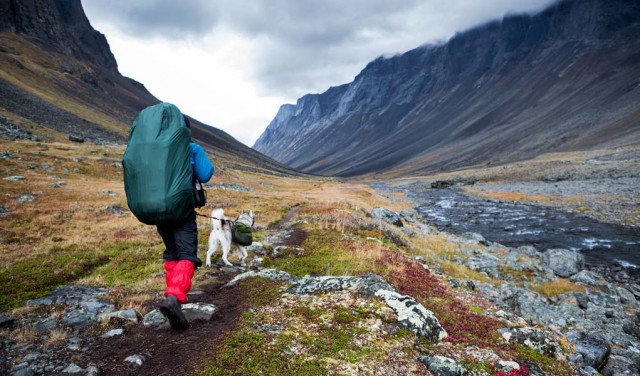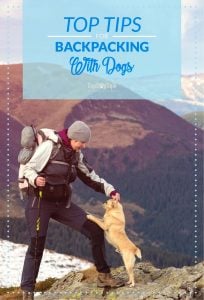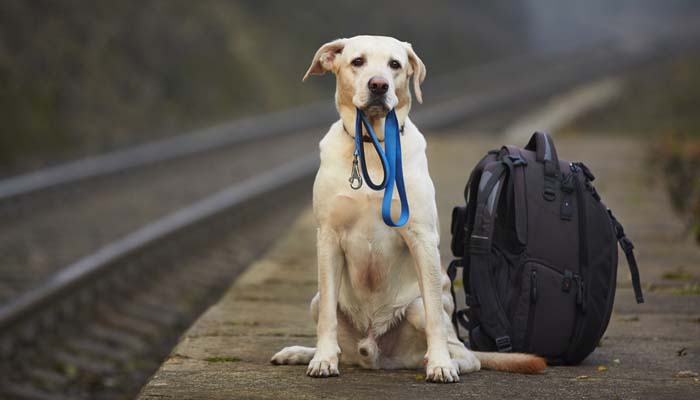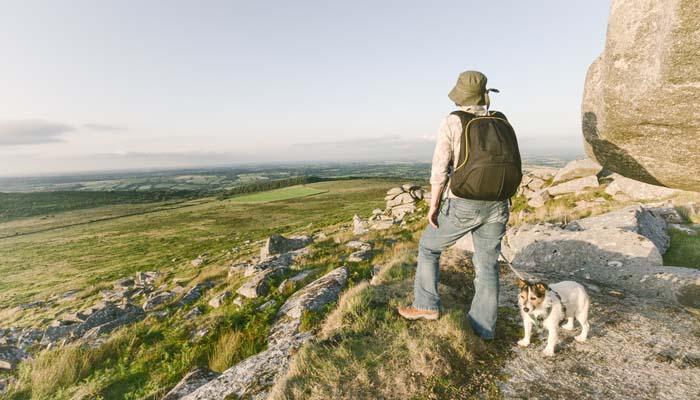
Table of Contents
The cool mountain air ruffles your hair as you stare out over a serene lake, autumn colors reflected in the still water. The song of a red-winged blackbird drifts across the canyon as you crunch on a handful of trail mix. What a lovely day for backpacking with dogs.
 For those of us who like to get up into the hills and stretch our legs, a day of hiking is the best getaway. But, most dogs love to get out of the house and smell the pines and fresh breeze too. So, why not take your dog along on your next hiking trip?
For those of us who like to get up into the hills and stretch our legs, a day of hiking is the best getaway. But, most dogs love to get out of the house and smell the pines and fresh breeze too. So, why not take your dog along on your next hiking trip?
All you need to do is prepare well. Consider what are the important safety tips you have to keep in mind, what type of essential equipment to take with you (such as dog GPS collars in case you lose your pet) and everything you need to know about locations.
Before you pack Fido into the car and head out of town though, you should take some time to prepare. This way, both you and your dog will have a safe and comfortable trip. Though it isn't much, there are some essential items that you'll have to take along for your four-legged friend.
READ THIS: 14 Safety Tips and Tricks for Hiking With Your Dog
How to Go Backpacking with Dogs
The first thing to consider when you’re planning on backpacking with dogs is your pet’s physical condition. Start at your veterinarian’s office. Let them know you’re considering hitting the trail and ask if there are any concerns he or she has.
Overweight, elderly, or dogs with joint issues may need to settle for neighborhood jaunts instead of mountain climbs. Dogs, like people, need to work their way up to any strenuous exercise. Don’t take your pooch on a 3-day hike up a steep trail her first time out.
If you’ve gotten the go-ahead from your vet as far as your dog’s medical health goes, consider also your dog’s psychological health. Is he well socialized? How does he react to other dogs? Joggers?
Keep in mind that you’re likely to encounter mountain bikers, horses, and all sorts of wildlife as well, depending on the type of trail you choose and what time of year you go.
RELATED: Camping With Dogs – Tips, Guidelines, Do’s And Don’ts
Choosing a Hiking Location
Assuming your dog is physically fit and knows how to heel, the next step is to hunt for dog-friendly trails. Here are just a few resources than can help in your search for a great hike:
- National Park Service: While not all of our nation’s parks allow dogs, the National Park Service website can tell you which parks are okay for backpacking with dogs and what rules you and your dog will need to follow while out on the trails.
- hikewithyourdog.com: This site will let you search by state and lists national parks, state parks, and monuments that are okay to bring your dog along to. There’s also a “favorite hikes” section with recommendations for the best trails.
- The Sierra Club: The well-known national organization has many local chapters. Use their main site to search for the chapter nearest to you and try the local site’s trail listings or forums.
- Meetup: While Meetup hosts all sorts of clubs and events, you’re likely to find a number of camping, hiking, and outdoors groups worth joining. The best source for dog-friendly trails in your particular region of the country are other experienced hikers and dog lovers who can give you a first-hand account of what areas are best and which are best avoided.
RELATED: Hiking with a Dog? Here's What You Need to Know
 Pack the Dog's Hiking Gear (And Yours)
Pack the Dog's Hiking Gear (And Yours)
Once you’ve picked out a location that’s appropriate for your dog’s physical and behavioral level, it’s time to gear up!
Whether you choose to carry supplies for the both of you while backpacking with dogs, or outfit your pet with his own pack, there are some essential items you won’t want to leave without.
Make sure you have a list of everything you need and check the boxes. The below link will walk you through everything you need to have when backpacking or hiking with dogs.
SEE HERE: Dog Hiking Gear Guide – 13 Items You Need for Hiking With Dogs
If you don't want to read the detailed article, here’s a quick list of the basics below.
Water – Take along enough water for yourself and your dog. Of course, you’ll want to pack more if the hike is long or the weather is hot. Dogs are susceptible to infection from the many bacteria found in rivers and streams, just as we are. So, be sure to keep your pet away from drinking from natural sources.
- Advice: Must-haves for hiking with dogs
First Aid Kit – It’s a good idea to learn some basic canine first aid applications before you go out. If your dog gets injured on the trail, you could be miles from emergency veterinary assistance. Learning how to treat common injuries could save your dog’s life.
Insect Repellent – Just as you would protect yourself from insect pests, give your dog a bit of repellent. There are several products on the market specially designed to be used on pets.
Do not use repellents meant for humans while backpacking with dogs, unless your vet recommends a specific product. Even though your dog has a protective coat of hair, insects like ticks and chiggers can dig their way into the skin. Pests like these can spread disease and do some serious damage to your dog's health.
Leash – Most national parks have leash rules to protect both your dog and the endemic wildlife. If you have a retractable style leash, it’s best to leave it at home as it most likely will not meet park regulations and won’t give you the needed control if a mountain bike comes suddenly speeding past.
- Review: What is the best dog leash?
Waste bags – Even though it may seem unappealing to carry your dog’s waste on the trail, leaving it out can cause harm to the environment and local animals. A quick internet search will yield a plethora of websites and articles that explain the health and ecological concerns with not picking up after your pooch.
Dog footwear – Depending on the conditions of the trail and how accustomed your dog is to being outdoors, you may want to consider some protection for your dog’s feet. There are several styles of booties on the market, as well as protective salves. These can protect your dog from sharp rocks, insect stings, and ice.
- Advice: Does your puppy need dog boots?
Once you’ve both returned from your day (or weekend) out in the wilderness, remember to do some after-care. Take the time to check yourself and your dog for burrs and insect parasites. Look at your dog’s paws to make sure there are no cuts or thorns.
Keep an eye on your dog in the following few days to watch for soreness or bumps developing. If you notice your dog walking gingerly or moving slowly, you may want to scale back the trail level next time, and visit your vet again to make certain there are no serious injuries.
Precautions such as getting your dog microchipped, buying him a customized collar with your personal information, or even using one of those dog GPS collars so that you can locate your pooch anywhere at any time is a good idea.
A well-prepared hiker is a happy hiker, and the same goes for your doggy companion. As long as you’ve followed a few safety precautions and packed along the right supplies, the both of you should have a great time in the great outdoors!
READ NEXT: Top 5 Best Dog GPS Collars for Dogs














